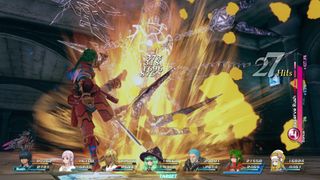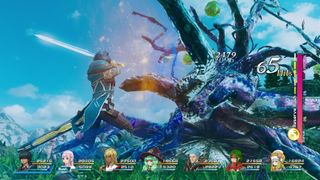'Star Ocean: Integrity And Faithlessness' For PS4, Hands On At PAX East

The development team at tri-Ace recently released the latest Star Ocean PS4 title, with the sub-title Integrity and Faithlessness, last month in Japan. However, it’s also planning a Western release of the same game on June 28, and I was able to play it for a full two hours at PAX East, thanks to Square Enix, the series' publisher.
Star Ocean: Integrity and Faithlessness might be the latest installment in the long-running series—which contains elements of sci-fi, action and role-playing games (RPGs)—but in terms of its place in the Star Ocean universe, the game’s events take place between the second and third game in the main series, Star Ocean: The Second Story and Star Ocean: Till the End of Time, respectively. You start the adventure in the role of Fidel, a swordsman in a coastal town who eventually becomes involved in a conflict that puts the land’s three major kingdoms on the brink of war.
A New World
As I sat down to begin the demo, a PR rep from Square Enix asked if I had any prior experience with the series. I didn't. He assured me that was fine, as Integrity and Faithfulness was more accessible to first-time players of the series. I noticed this first-hand in the opening sequence of the game. As Fidel and a friend were sparring in the middle of the platform, the game provided me with a few pop-up tutorials about combat (the Circle button executes a strong attack and the X button is a weak attack). Later on, you also discover that there are multiple attacks with the two buttons, based on your distance from the targeted enemy.
As I walked around the coastal town and progressed through the story, the game would sometimes pause to give me some tutorials on new mechanics such as skills, roles and party management, all of which would be useful very soon. Some would consider this tutorial method as intrusive because it constantly interrupts the flow of gameplay. However, I actually preferred it, as it allowed me to play portions of the game, and then get introduced to new concepts as I progressed. It’s an alternate hand-holding method throughout the first few levels that allows you to have some freedom in gameplay without creating an entire tutorial level.

With the Star Ocean series deeply rooted in its RPG mechanics, the game also includes character management. Over time, you gain new members in your party, to the point where you could have seven characters in one group, and you have the ability to switch which ones you control at any time. On top of that, you also have to manage their weapons and armor, but more importantly, their skills and roles. The roles are what define each character’s actions in combat to give them a better chance of surviving each conflict. For example, I could have a majority of my characters as Fighters while some played the defensive role to attract enemies, and I could also assign a Healer to keep the group alive.
In addition to these roles, you’ll also get various skills that fall under each category. For example, a Fighter role is further improved with skills that increase its attack or overall critical damage output. A Healer can benefit from more magic points to use, and a Defense class can withstand more damage with more health points.
Each character has additional abilities that can be assigned to the X and Circle attacks to change the overall attack strategy. However, finding new abilities requires various books that you pick up throughout the world, so it’s important to keep an eye out for any and all treasures.
Stay on the Cutting Edge
Join the experts who read Tom's Hardware for the inside track on enthusiast PC tech news — and have for over 25 years. We'll send breaking news and in-depth reviews of CPUs, GPUs, AI, maker hardware and more straight to your inbox.
If that wasn’t enough, you can also allocate the skill points you earn in combat towards specialties, or abilities that help with item crafting. This includes harvesting, which allows you to gather resources from plants, or the ability to excavate in order to get minerals.
All in all, its features are what you would expect out of a Japanese RPG: The combat system is somewhat easy to learn, but the real core of the game lies in how well you manage each character in your party.
Execute
I began with two characters in my party, which meant that it took some effort to take out the first batch of enemies I encountered, but these first foes didn't pose much of a challenge . After the brief tutorials and the introduction to the game’s story, I left the coastal town to continue my progress. Later on, two more characters joined my party, which made combat much easier. With two buttons governing your attacks, it doesn’t take long to master your fighting skills. However, it does take considerable effort to ensure that each member of your party is putting his or her best foot forward.
This means considerable time managing skills and abilities. With each battle, the party gained skill points, and I had to decide who would benefit the most from additional skills. Visit any town on the map, and you’ll also encounter vendors who sell books containing spells, fighting abilities, armor and weapons, so you’ll also have to wisely manage your spending habits.
As for the world itself, there are various levels that are expansive, and it contains more enemies and treasure than you can imagine. However, there are small pockets of linear-based levels, as well. These small areas do allow for some exploration, but it’s not hard to stick to the path towards the next area.

For the last half hour of the demo, the Square Enix rep returned to load a later save in the game that had me controlling six characters, all with advanced abilities and skills. Combat is chaotic, to say the least, with this many characters on screen. In addition to various sword slashes, I saw bursts of magic hit enemies while other allies yelled as they sliced through opponents. I still had to manage certain team aspects, such as changing a few roles and abilities to suit my fighting style, but for the most part, everything was already set for me.
Unfortunately, it wasn’t enough to take on the main boss of the level, a giant mechanized creature complete with human minions. The overall firepower and strength proved to be too much for my team, as each member dropped dead one by one. Even with my changes, the final fight was out of my depth.
Back For More
Still, I had my fill of fun with the demo. Japanese RPGs aren’t my forte when it comes to games, but I found myself invested with each member of team, mostly because I had complete control over their abilities and roles in combat. It was rewarding to see how my actions in management played out on the battlefield, and most of the time it’s trial and error.
It’s hard to determine, at least for me, how this installment stacks up against other Star Ocean titles, but as a newcomer to the series, Integrity and Faithlessness wasn’t an intimidating game. The tutorials for various features were well-presented, and the game’s progression allowed me to get comfortable with a small party and easy enemies before increasing the difficulty with more members. It might take me some time to master my party management skills, but at least I have an idea of what to expect when the full game comes out in a few months on the PlayStation 4.
Follow Rexly Peñaflorida II @Heirdeux. Follow us @tomshardware, on Facebook and on Google+.
Most Popular

